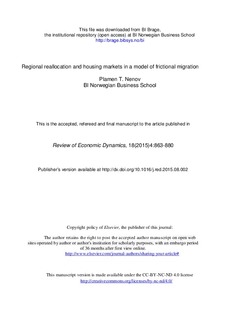Regional reallocation and housing markets in a model of frictional migration
Journal article, Peer reviewed
Permanent lenke
http://hdl.handle.net/11250/2374552Utgivelsesdato
2015Metadata
Vis full innførselSamlinger
- Scientific articles [2181]
Sammendrag
Migration frictions are important for understanding key features of gross migration and housing markets. This paper studies a multi-region equilibrium model with frictional migration. Idiosyncratic preference shocks, a mobility cost, and imperfectly directed migration lead to slow worker reallocation in response to changes in local conditions. This leads to a dependence of local house prices on the history of labor market shocks. The model accounts for the comovements of unemployment and rental and house prices with gross migration observed in a panel of U.S. cities. Structural estimation reveals a high mobility cost for unemployed workers and a low probability of directed migration. Both of these imply that regional reallocation has a limited importance for the aggregate labor market and that the e ects of housing markets on reallocation are small.
Beskrivelse
This is the author's accepted and refereed manuscript of the article
